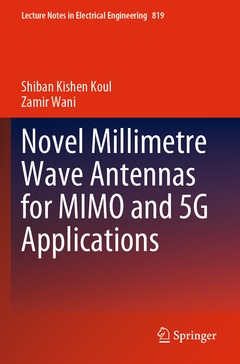Description
Novel Millimetre Wave Antennas for MIMO and 5G Applications, 1st ed. 2021
Lecture Notes in Electrical Engineering Series, Vol. 819
Authors: Koul Shiban Kishen, Wani Zamir
Language: English
Subjects for Novel Millimetre Wave Antennas for MIMO and 5G Applications:
Approximative price 116.04 €
In Print (Delivery period: 15 days).
Add to cartPublication date: 12-2022
171 p. · 15.5x23.5 cm · Paperback
Approximative price 158.24 €
In Print (Delivery period: 15 days).
Add to cartPublication date: 12-2021
Support: Print on demand
Description
/li>Contents
/li>Biography
/li>Comment
/li>
1. Millimeter Wave for Gigabit Wireless
1.1 Millimeter Waves for Gigabit Wireless1.2 Millimeter Wave 5G Frequency Bands
1.2.1 The 28-GHz Band
1.2.2 Propagation Losses
1.2.3 Channel Characteristics
1.2.4 Link Budget
1.3 Millimeter Wave Antennas1.3.1 Antenna Design and Requirements
1.4 Millimeter Wave MIMO and Beamforming1.5 Conclusion
References
2. Metamaterials and Anisotropic Media Realization for mmWave Applications
2.1 Introduction
2.2 Metamaterials for Antennas
2.3 Uniaxial Anisotropic Media for mmWaves
2.3.1 Media Properties
2.3.1 Unit Cell and Metamaterial Realization
2.4 Biaxial Media for mmWave Antennas
2.4.1 Media Properties and Antenna Applications
2.5 Propagation of Waves through Uniaxial Anisotropic Media
2.6 Propagation of Waves Through Biaxial Anisotropic Media
2.7 Conclusion
References
3. mmWave High Gain Antennas
3.1 Introduction
3.2 Antenna Gain versus Size3.3 Gain Enhancement Techniques
3.4 Stacked Dielectric Loading for Gain Enhancement3.4.1 Design and Working Mechanism
3.5 High-Low-Epsilon Media for Gain Enhancement3.5.1 Basic Theory and Working Principle
3.5.2 Lens Property of HLE Media3.5.3 Antenna Gain Study
3.6 Conclusion
References
4. Beam Tilting/Deflection Antennas
4.1 Introduction
4.2 Beam Tilting using High Permittivity Media
4.2.1 Dipole Antenna with CLL Array4.2.2 Beam Tilting Mechanism
4.3 Huygen’s Metasurface4.3.1 Design of Phase Delaying Elements
4.3.2 Design of Metasurface
4.4 Aperture Coupled Antenna With The Metasurface
4.4.1 Beam Tilting Mechanism
4.4.2 Results
4.5 Two Antenna Array With The Metasurface
4.6 Conclusion
References
5. Beam Switching and Wide Scan Antenna Array
5.1 Introduction
5.2 Gain Enhancement and Beam Deflection
5.2.1 CLL Unit Cell Design
5.2.2 Dipole Antenna with CLL Array
5.3 Three Antenna Array
5.4 Wide-Scan Antenna Array with CLL Array
5.5 Beam Switching Antenna
5.6 Results and Discussion
5.7 Conclusion
References
6. mmWave MIMO Antennas
6.2 MIMO Antenna Design
6.3 Two and Four Element Antenna Development6.4 MIMO Antenna Performance Parameters
6.4.1 ECC and Multiplexing Efficiency
6.4.2 Diversity and Channel Capacity
6.5 Results and Discussion
6.6 Conclusion
References
7. mmWave Dual Polarization Antennas
7.1 Introduction
7.2 Antenna Polarization and Applications
7.2.1 Polarization Diversity7.3 Dual Polarization Antennas
7.4 Generation of Dual-Polarization
7.5 Two Port Dual-Polarization Antenna
7.5 1 Design and Radiation Characteristics
7.6 Quad-Beam Antenna for 5G Massive MIMO Applications
7.6.1 Design of Superstrate
7.6.2 Radiation and MIMO Performance
7.7 Results and Discussion
7.9 ConclusionReferences
8. Dual beam/Multibeam Antennas8.1 Introduction
8.2 Dual-beam Antenna Array
8.2.1 Dual-beam MIMO and Performance
8.3 Dual-Beam Radiation using Uniaxial Anisotropic Media 8.2.1 Theory and Mechanism of Single-EH Media8.2.1 Gaussian Source and Dual beam Splitting
8.4 Dipole Antenna with Single-EH Media 8.4.1 Radiation Pattern Study8.5 SIW Dipole Antenna with Single-EH Media
8.5.1 Metamaterial/Dielectric Realized Media with the Antenna
8.6 Prototype and Measurement Results8.7 Conclusion
References
9. mmWave Lens Antennas
9.1 Introduction
9.2 Lens Antennas and PDM Technique
9.3 Thin Metamaterial Lens
9.3.1 Subwavelength Resonator Design
9.3.2 Configuration and Lens Design
9.3.2 Study of Lensing property
9.4 Circularly Polarized Antenna Array
9.5 Antenna Array with Metamaterial Lens
9.6 Measurement Results and Discussion
9.7 Conclusion
References
IndexPresents state-of-the-art millimeter wave antennas for next generation 5G communications
Discusses new metamaterial-based antennas employing uniaxial or biaxial anisotropic media
Includes lens antennas and the design of very thin planar metamaterial lens for 5G massive MIMO applications




